Minister’s Annual Report on Lake Simcoe, 2016
Read a summary of actions taken during 2016 to protect and restore Lake Simcoe, as well as advice from two advisory committees.
Minister’s message
The 2016 Lake Simcoe Annual Report describes a sample of the incredible work that is being undertaken by many partners to revitalize the lake and watershed. The passing of key legislation, the Lake Simcoe Protection Act, and its companion, the Lake Simcoe Protection Plan has provided the foundation for success.
On this page you will read about 21st century solutions to address the challenges we are encountering in the watershed in the context of a changing climate, population growth and the continual threat of invasive species. We are using science and technology to help restore water quality and to protect water quality and quantity for the people and wildlife that rely on the lake.
For the first time, we will be using environmental monitoring drones as part of a plan for the lake and watershed. This will help us determine whether it is possible to locate brook trout habitat in a more efficient way. Lake Simcoe monitoring is also showing that road salt can negatively impact our waterways. The conservation authority, with our support, is developing design standards to reduce salt application in parking lots and municipalities are developing engineering standards templates. Low Impact Development (LID) has quickly emerged as a necessary tool to manage stormwater and reduce urban runoff and is being utilized in the watershed for new developments. I invite you to read more about these significant projects in this report.
I am proud of the work that has been accomplished over the past year. Our success rests upon the leadership of many partners, including the Lake Simcoe Region Conservation Authority (LSRCA), watershed municipalities, the Lake Simcoe Science Committee, Lake Simcoe Coordinating Committee, the Indigenous community and the many environmental organizations, educators, businesses and residents who contribute to the protection of the lake. Thank you for your contribution! I look forward to our continued collaboration as we deliver on our commitments in the Lake Simcoe Protection Plan.
The Honourable Glen Murray
Minister of the Environment and Climate Change
Government of Ontario
Introduction
Ouentironk, a Huron word meaning "beautiful water" was the first name given to Lake Simcoe in the 17th century by the Indigenous people who lived along its shores. This ecologically diverse body of water and the landscape that surrounds it has long been valued as an essential natural resource. It is the largest inland lake in southern Ontario outside of the Great Lakes and is home to natural heritage features including wetlands, woodlands and wildlife. Its watershed supplies drinking water to the local population and contains the traditional lands of many Indigenous people.
Protecting the lake means safeguarding drinking water, preserving habitat for native flora and fauna, sustaining a major agricultural area, and supporting recreation which generates millions of dollars annually for the local economy. The Lake Simcoe Protection Act (2008) is the main tool used to protect and restore Lake Simcoe. The Lake Simcoe Protection Plan (the Plan), established in 2009, was the first of its kind in Ontario to identify threats at a watershed scale and propose actions to address them. Implementing the Plan continues to be a key priority for the province and our partners.
The province’s commitment to protecting the lake is reflected in the many achievements outlined in this annual report. It highlights work undertaken since the release of the Minister’s Annual Report on Lake Simcoe, 2015 including key actions to reduce phosphorus loading to the lake and address emerging priorities such as chloride levels and climate change.
We are seeing improvements in water quality, which helps to support aquatic life in the lake and a healthy Lake Simcoe watershed. Between the 1980s and 2016, water quality has shown signs of improvement. Springtime phosphorus levels decreased, while the end-of-summer deepwater dissolved oxygen level increased.
The province and its partners actively undertake research and monitoring of the aquatic and terrestrial components of the lake and its watershed. The results help guide our adaptive management approach to restoring and protecting the health of the Lake.
Our vision for Lake Simcoe includes:
- a healthy environment where communities can enjoy all of the recreational and economic benefits of living within the watershed
- a healthy ecosystem for the many native species of fish, wildlife and plants that make Lake Simcoe a treasured resource
- natural shorelines where development is well-planned and sustainable for future generations
- greater cooperation and leadership among all partners who work to protect the lake
This report will focus on projects and initiatives that fall within the following categories:
- water quality
- water quantity
- climate change
- natural heritage
- stewardship
- fisheries
- invasive species
- agriculture
- recreation
Water quality
A clean and sustainable water supply is critical to ecosystem function and human health and well-being. Human activities, including the production of excessive nutrients, pollutants, invasive species, development and recreational activities have impacted the water quality of the lake and its tributaries.
One of the greatest impacts on the water quality of Lake Simcoe is caused by excess phosphorus entering the lake through tributaries collecting runoff from urban centres and agricultural and natural areas. Phosphorus contributes to algae and aquatic plant growth. The more phosphorus there is in the lake, the more plant and algae growth, and eventually decomposition. When aquatic plants and algae decompose, oxygen is consumed and dissolved oxygen decreases. Just like humans need air to breathe, aquatic organisms need dissolved oxygen to breathe and survive.
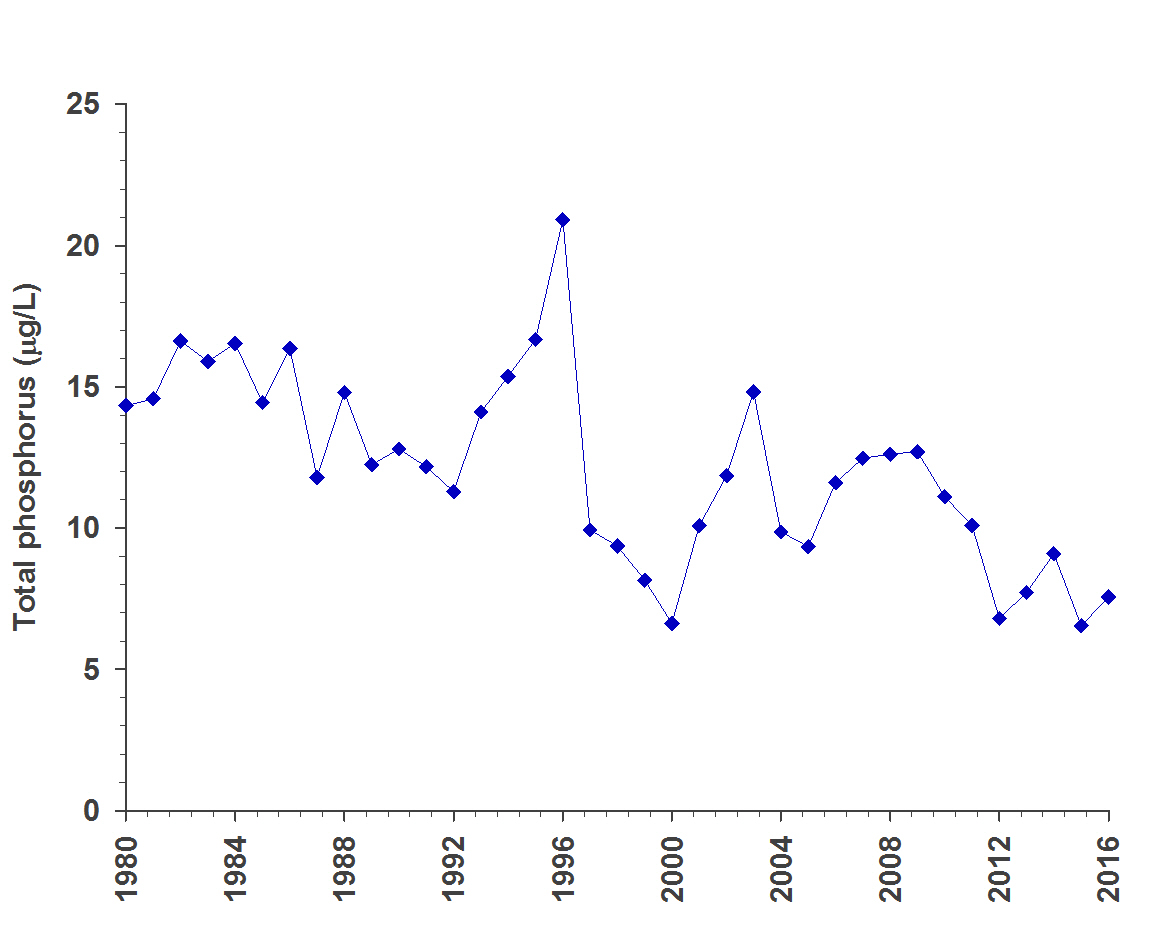
Graph of Changes in Spring Total Phosphorus Average Concentration from Multiple Sampling Events in Lake Simcoe (1980 to 2016)

Graph of Changes in Deepwater Oxygen in Lake Simcoe (1980 to 2016) with the Plan target of 7 micrograms per litre indicated by the dotted line.
Low Impact Development (LID) Treatment Train Tool
LID is a term that describes a range of features that aim to reduce the impacts of urban stormwater such as increased runoff and sedimentation. They do so by mimicking natural processes in built infrastructure by capturing water for reuse, releasing it slowly to nearby watercourses or allowing it to infiltrate into the soil.
A Low Impact Development Treatment Train Tool has been developed for the Sustainable Technologies Evaluation Program (STEP) by participating Greater Toronto Area Conservation Authorities, with additional partnership support from the Ministry of the Environment and Climate Change (MOECC). It will help developers, consultants, municipalities and landowners understand and implement more sustainable stormwater management planning and design practices in their watersheds. This tool provides a quick and consistent approach to lot-level phosphorus loads and water budgets and will help developers determine appropriate LID features to install. This open-source tool will be available for download by practitioners via the STEP website in 2017.
Phosphorus Offsetting
Lake Simcoe Region Conservation Authority (LSRCA) is continuing with its Lake Simcoe Phosphorus Offsetting Program (LSPOP) pilot to improve and protect water quality. The LSPOP will use tools such as LID practices to manage phosphorus discharges from new residential construction and will create opportunities to invest in stormwater retrofits. It will also encourage innovation in the design of new residential development.
Sewage Treatment Plants
There are 14 municipal and one industrial Sewage Treatment Plants (STPs) within the Lake Simcoe watershed. Seven of the STPs discharge directly into Lake Simcoe while the other eight discharge into rivers that flow in the lake. Prior to the LSPP, the average annual phosphorus load from the STPs was approximately 5 tonnes per year. The province has worked with STP plant owners to meet the more restrictive phosphorus limits that came into effect in 2015 as a requirement of the Phosphorus Reduction Strategy. As a result, the STPs in the Lake Simcoe watershed are among the most innovative and effective in removing phosphorus in Ontario. In 2016, the total amount of phosphorus going into the lake from STPs was just under 2 tonnes; this is more than a 50% reduction from pre-LSPP levels. The reduction of phosphorus coming from the STPs is considered a significant achievement given the increased pressure from urban development and climate change that they continue to encounter.
Tracking Stormwater Management Works
The LSRCA held a number of workshops with municipal staff to share best practices for inspection, maintenance and record keeping of municipal stormwater management assets and to inform the design of a data model. On its own, the construction of stormwater management facilities is insufficient to protect water quality. Facility owners need to regularly inspect and maintain stormwater management works, such as stormwater ponds and oil grit separators, to ensure that they function as they were designed. Making sure these facilities are regularly inspected and maintained is an important step to managing risks of flood and water quality impacts. Participants co-designed a framework for a stormwater database that reflects current best practices around the watershed and beyond. The database supports municipal inspection and maintenance activities and serves as an example of how owners can work together to address the issue of aging infrastructure.
Remote Sensing
Excess nutrients are a significant environmental concern in the Lake Simcoe watershed. Understanding where these nutrients come from and how they impact tributaries and the lake is critical to directing future management of the watershed. The St. Lawrence River Institute is conducting a proof-of-concept study to see if remote sensing imagery can be used to spatially assess nutrient loads to improve our knowledge of non-point sources of nutrients. Fieldwork was completed this past summer and fall and model development is underway. Additional field work is planned for the summer of 2017 to validate and refine the model with the final version targeted for completion in early 2018.
Managing Road Salt
As the population around the Lake continues to grow, more paved surfaces like roads and parking lots need to be de-iced. Since 2000 there has been a significant increase in chloride concentrations in the lake. Salt application in the watershed is currently estimated to be 90,000 tonnes per year. Chloride entering the lake and streams is a growing concern. Monitoring data indicates that chloride concentrations are increasing in the lake and its tributaries. This trend is likely the results of salt-rich melt water entering the stormwater system and discharging to local water courses.
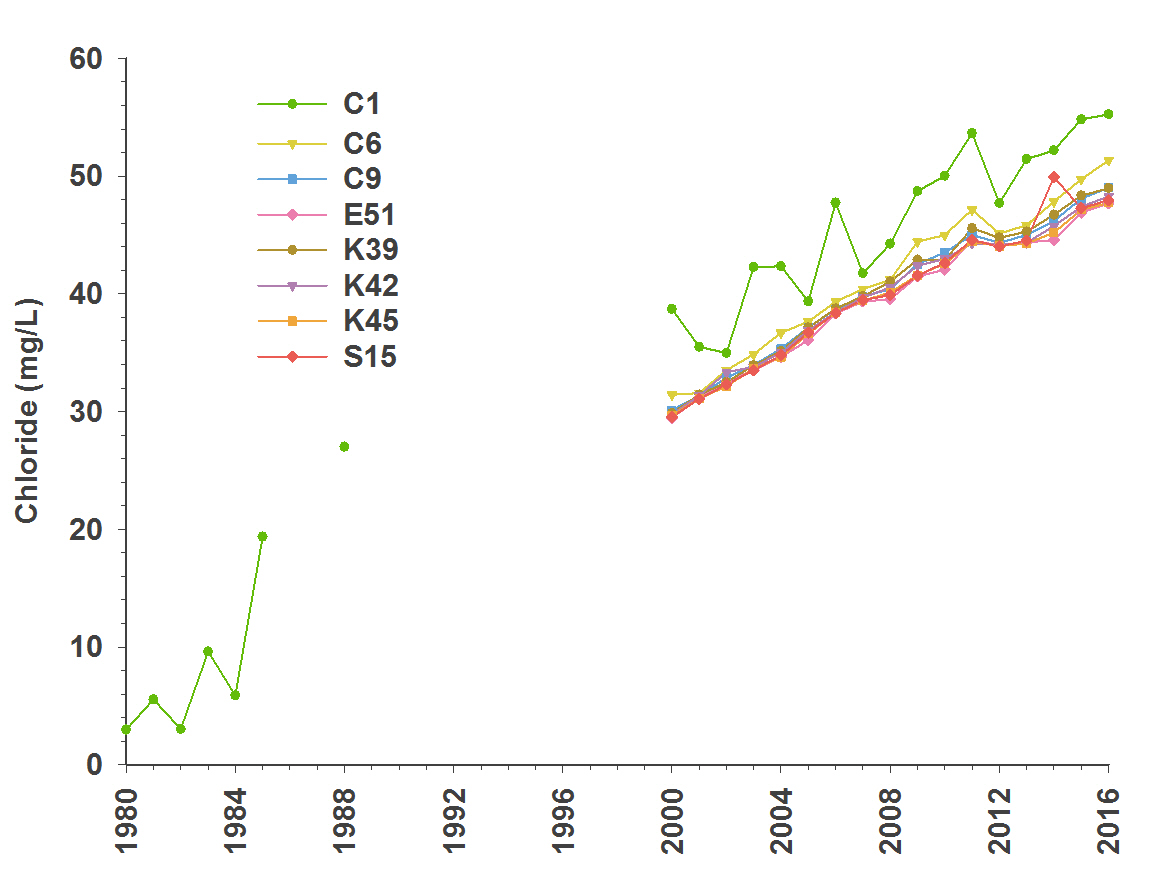
Graph of Changes in Average Chloride Concentrations at Eight Lake Stations around Lake Simcoe 1980 to 2016)
The LSRCA has been leading discussions with municipalities and contractors to encourage the exchange of best practices for reducing winter salt application rates while maintaining safety.
The LSRCA recently completed a project to develop parking lot design standards that reduce chloride application in parking lots in partnership with the development industry, winter maintenance contractors and municipalities. Municipal Official Plan policies and engineering standards templates are being developed to assist municipalities in adopting these new standards while protecting public health and safety. These guidelines are available on the LSRCA website.
The Smart About Salt Council, a not-for-profit corporation established to protect freshwater from road salt, received funding to implement a bilingual, online training system for winter maintenance professionals and facility operators which will provide courses on winter maintenance practices.

Figure: Example of the Smart About Salt Council’s online training website. Photo Credit: Smart About Salt Council.
Septic Systems
When septic systems are properly designed, constructed and maintained, they effectively reduce or eliminate most human health or environmental threats posed by pollutants in household wastewater. In 2015, inspections of all septic systems within 100 metres of Lake Simcoe were completed. These systems will now need to be re-inspected every five years. To help with Phase 2 of this work, MOECC and LSRCA provided municipalities with maps of the land near ponds, permanent rivers and streams in the Lake Simcoe watershed. Any septic systems within this area will need to be inspected by January 1, 2021, and they will also be put on a five year re-inspection cycle.
Water quantity
Maintaining water flows through the Lake Simcoe watershed is essential to the protection of ecological integrity and to meeting community water needs. Increased populations and climate change can cause water quantity issues. As a result, there could be changes in the aquatic habitats of rivers and streams, and aquatic communities and the ecological functions of natural areas and shorelines can be impacted.
Environmental Flows
The LSRCA, with support from the province, is continuing to lead research to estimate the flows needed to maintain healthy aquatic ecosystems in tributaries of Lake Simcoe. Environmental flows (e-flows) describe the quantity, duration, timing and quality of flow necessary to sustain freshwater ecosystems. This approach is also used to model different scenarios to show how changes in climate could influence the system. In 2016, an e-flow framework for Lover’s Creek was completed and the East Holland River e-flow framework is scheduled to be completed in 2018. The results of this research will be shared with key stakeholders and integrated as part of the adaptive management approach in the Plan.
Promoting Rain Gardens
The province funded Landscape Ontario to develop a series of seven videos for homeowners providing tips on how to design and build a rain garden. These attractive landscape features capture and clean fresh water close to the place it lands on residential properties. The videos explain how rain gardens function to help prevent clean roof water from running across hard surfaces where it can collect pollutants and overload local infrastructure during severe weather.
Climate change
Ontario is taking a leadership role in the fight against climate change. The province’s Climate Change Action Plan establishes forward thinking policies and programs to reduce greenhouse gas emissions and move the province toward a low carbon future. Due to many factors, including rapid human growth, climate change impacts on the ecological health of the watershed are being seen. As a result, climate change adaptation is a priority in the Lake Simcoe watershed. Actions to reduce our vulnerabilities and adapt to the impacts of climate change, such as extreme weather events, are taking place throughout the watershed.
Lake Simcoe Climate Change Adaptation Strategy
The Lake Simcoe Climate Change Adaptation Strategy was released in February 2017 and provides a framework to drive actions to adapt to our changing climate. The changing climate will affect Lake Simcoe’s water quality and quantity, aquatic and terrestrial ecosystem structure and function, and the frequency of extreme weather events. It could also cause damage to natural areas and shorelines. These changes will influence the way communities throughout the Lake Simcoe watershed manage natural assets and the infrastructure that has been built around them. Actions to address and adapt to climate change are essential to respond to the ecological threats and opportunities ahead of us and are being implemented throughout the watershed in collaboration with a range of stakeholders.
The Lake Simcoe Climate Change Adaptation Strategy

Figure: The Lake Simcoe Climate Change Adaptation Strategy is a collaborative approach that considers specific areas that will likely be impacted by climate change and provides a framework for all stakeholders to take action.
Adapting for climate change requires enhancing and protecting the watershed’s capacity to cope and helping people adjust their behaviour and associated activities to meet current and emerging challenges.
- Infrastructure and Business Operations
- Agriculture
- Recreational Activities
- Invasive Species
- Water Quality and Quantity
- Aquatic life, shoreline and natural heritage
Ogemawajh First Nations Adaptation Strategy
The province supported the Chippewas of Georgina Island First Nation’s (CGIFN) development of a Climate Change Adaptation Strategy. It is based on the collection of Traditional Ecological Knowledge about changing climate and weather, plants, animals, land, and water. The project resulted in the CGIFN working with the Indigenous communities of Beausoleil and Rama to assess vulnerability and share knowledge about climate change impacts. In April 2016, the CGIFN hosted a one-day information workshop, in partnership with Georgian College, to share their findings about the project and how the knowledge collected is being shared and used by other Indigenous Peoples in and around the Lake Simcoe watershed.
Stormwater Management Pond Climate Risk Assessments
With funding from the province, the LSRCA is partnering with Ryerson University, Trent University and the University of Ontario Institute of Technology to evaluate the risks associated with aging infrastructure and the influence of changing climate on stormwater management ponds.
Through this project, pond owners have been engaged by the LSRCA in a discussion about physical and environmental risks associated with the state of selected stormwater management ponds. A risk assessment tool was developed to guide inspectors in the assessment of ten ponds. The project evaluates existing structures, their design features and environmental performance as settling basins that protect local streams. This work is being completed to help pond owners understand the physical and biological components of their stormwater management assets in the context of how they function as water quality and quantity structures under the influence of climate change.
A risk assessment methodology has been created and implemented and high resolution surveys of two stormwater management ponds have been completed. By monitoring the ponds during high flow events, we can better understand how ponds respond uniquely to weather patterns. This enables owners to plan for anticipated climate change impacts, such as more frequent intense rainstorm events. A comprehensive report to share project results with key stakeholders is planned for completion this year.
Natural heritage
Natural heritage features are vital components of the ecosystem and are closely linked to other elements such as water quality and quantity. Promoting and protecting the ecological health of the lake’s shoreline and the watershed’s natural heritage are important to fostering a resilient, adaptable and sustainable watershed.
Community Planning Permit System for the Innisfil Shoreline
The Town of Innisfil, in partnership with the province, the LSRCA and other shoreline communities has developed a model for implementing a Community Planning Permit System (CPPS) on the Lake Simcoe shoreline. The model includes in the definition of development site alteration and vegetation removal. As a result it has been used in other communities to protect natural shorelines, vegetated slopes and overall waterfront character.
Following extensive community consultation, the Town of Innisfil proposed a shoreline development approval process where the town coordinates shoreline permitting with the province and LSRCA. This approach will provide more certainty for landowners while ensuring the continued protection of the shoreline.
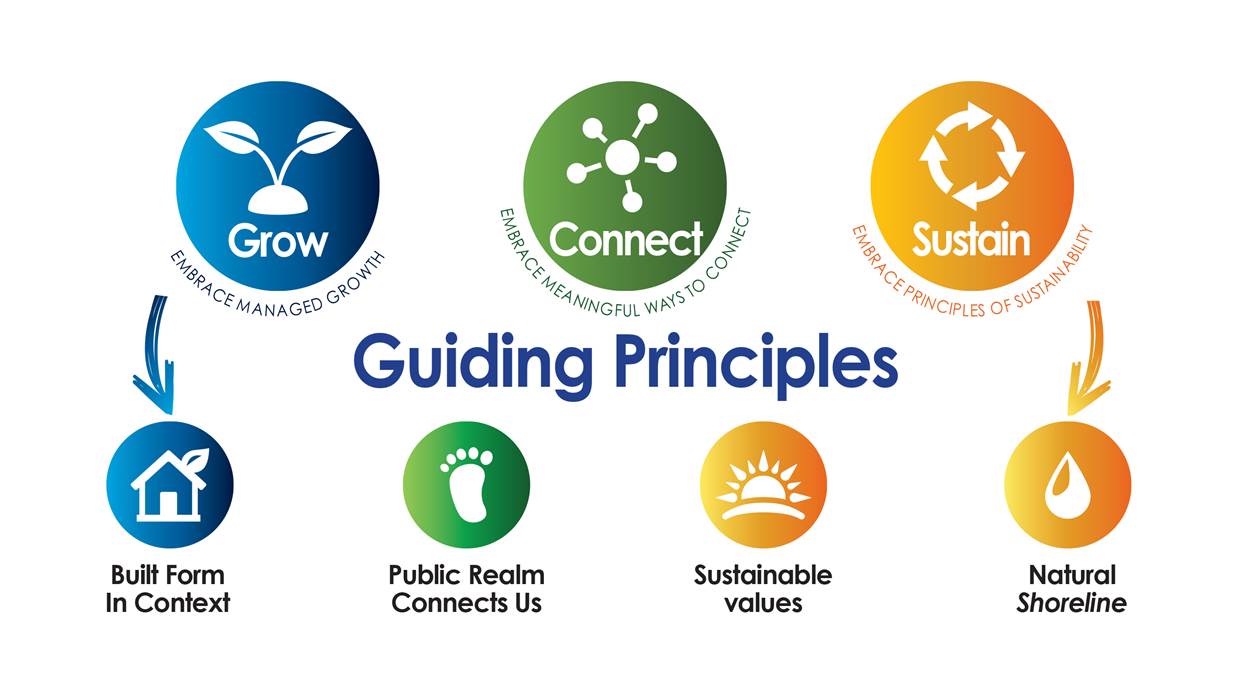
Figure: Guiding principles for the Town of Innisfil’s model for implementing a CPPS that ensure there is a balance between built form and natural shoreline features. Image Credit: Town of Innisfil
Guiding principles of Innisfil’s model
Grow
- Embrace Managed Growth
Connect
- Embrace Meaningful Ways to Connect
Sustain
- Embrace Principles of Sustainability
Built Form in Context
Public Realm Connects Us
Sustainable Values
Natural Shoreline
Subwatershed Plan Completion
All subwatershed plans for priority subwatersheds, including those for Georgina, Snake and Fox Islands, Ramara, and Whites Creek and Talbot River have been completed. The Georgina, Snake and Fox Islands subwatershed plan is unique as it was developed integrating traditional ecological knowledge with the LSRCA’s experience developing plans. Each plan is a comprehensive assessment of the health of the subwatershed and provides a set of recommendations to protect and restore its natural environment. The ongoing implementation of these subwatershed plans will result in better informed and prioritized management actions.
Stewardship
Stewardship, education, and outreach activities help us understand our influences on the Lake Simcoe watershed and encourage everyone to voluntarily take responsible and sustainable action. By engaging local businesses, government, community groups and landowners we can build on our continued successes engaging citizens and stakeholders, who have great interest in improving the health of Lake Simcoe through participation in a variety of stewardship projects.
Streams and Shorelines
The Ministry of Natural Resources and Forestry (MNRF) continued to support a number of stewardship activities to enhance Lake Simcoe’s natural features. This includes various restoration projects including wetland restoration by Ducks Unlimited Canada and stream and shoreline restoration work as part of the Lake Simcoe Stream Restoration Program.
Participants of the Ontario Stewardship Ranger program completed projects with a variety of partners within the Lake Simcoe watershed. These projects included trail maintenance, invasive species removal, boardwalk construction, seine fishing to determine fish species, age and size, and shoreline clean-ups.
Great Lakes Guardian Community Fund
As in previous years a number of projects in the Lake Simcoe watershed have received funding through the Great Lakes Guardian Community Fund. This past year the Lake Simcoe Conservation Foundation received funding to restore the ecological function of Lover’s Creek in Centennial Park in Barrie. The project involved designing and constructing a natural channel and wetland and removing the control structure to improve stream health. Community members were also engaged in planting native shrubs and trees.
Wild Rice Planting
MNRF staff continued with the Wild Rice Restoration Project, confirming the growth of previously planted wild rice. Wild rice planting currently occurs on the south side of Georgina Island and planting operations will be expanded in this upcoming year to Barnstable Bay. First Nations have assisted with the project through monitoring and traditional wild rice habitat identification. Through this project we are seeing the successful reintroduction of wild rice to the waters around Georgina Island.

Figure: Wild rice being collected. Photo Credit: MNRF Aurora District.
Fisheries
Healthy aquatic communities provide significant social and economic benefits to communities in and around the Lake Simcoe watershed. Also known as the “ice fishing capital of Canada,” Lake Simcoe is the most intensively fished inland lake wholly within the boundaries of Ontario. It is widely known for its lake trout, lake whitefish, yellow perch and smallmouth bass fisheries and draws an estimated one million angler hours per year. Changing lake conditions, due to both natural and human impacts, have had significant implications for fisheries, resulting in changes in recreational uses and associated socio-economic benefits.
Drone Pilot
MNRF piloted a program to test the use of drones to take high-resolution photographs and thermal images of the Beaver River. The data collected will inform whether it is possible to locate groundwater inputs remotely, which could indicate possible brook trout habitat.
Fisheries Monitoring
MNRF has been monitoring the Lake Simcoe aquatic community since the 1950s. In 2016, MNRF staff implemented a suite of aquatic monitoring surveys intended to assess the nearshore and offshore fish communities, fish biodiversity, the diet of the coldwater fishes, and the winter and open-water recreational fishery. Information gathered is being used to report on the health of the Lake Simcoe fish communities, the fisheries it supports and fisheries management decisions. For example, a combination of deep-water netting and angler catch sampling provides insight into the trends of natural and stocked lake trout and lake whitefish, including the extent of natural reproduction. This information is one source used to evaluate the coldwater stocking program.
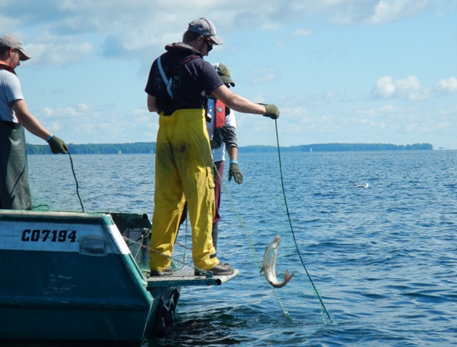
Figure: Biodiversity and monitoring staff doing fisheries monitoring surveys on Lake Simcoe Photo Credit: MNRF Aurora District.
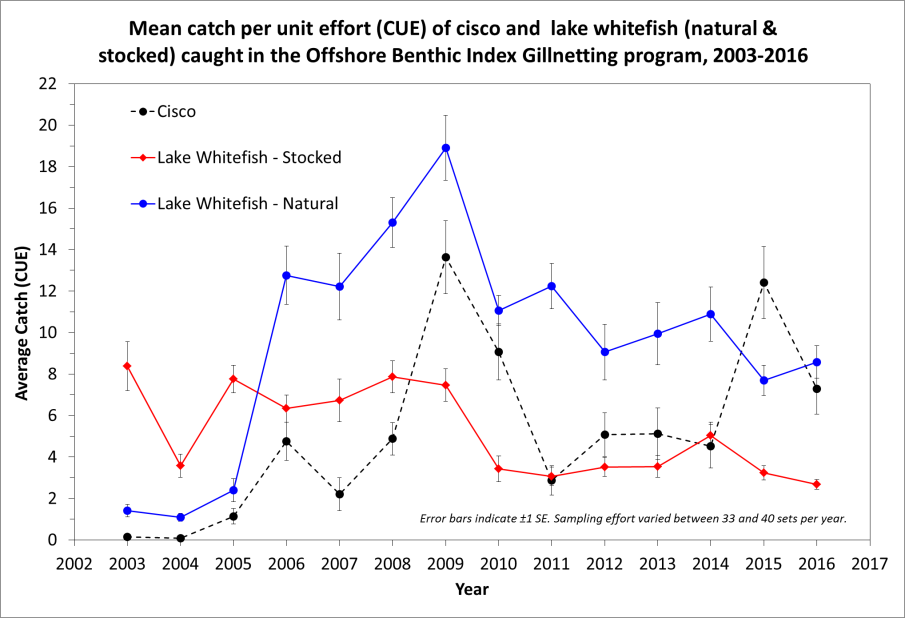
Figure: Graph showing relative abundance of cisco and lake whitefish (natural and stocked) caught in the deep-water netting program.
Lake Simcoe Muskellunge Restoration Project
MNRF staff continued work on this project aimed at re-establishing a stable, self-sustaining population of muskellunge (muskie) in Lake Simcoe. In 2016, working with MNRF staff and Fleming College, we were able to raise fish in hatcheries. These fish were later released into Lake Simcoe.
During this sampling a number of muskellunge, originating from the Kawartha Lakes System, were caught in the Talbot River. Although originating from another system, this discovery indicates that the Talbot River is suitable habitat for stocked individuals. Confirmation of the system’s suitability for stocked individuals came in the fall of 2016 when a Georgian Bay strain muskellunge was caught during effectiveness monitoring in the Talbot River – a great sign pointing to early successes in stocking efforts.
Classroom Hatchery Program
MNRF continued partnering with two elementary schools to create coldwater fish nurseries for lake trout, a species of fish native to Lake Simcoe. Georgina Island First Nation Elementary School (Waabgon Gamig) and Morning Glory Public School in Pefferlaw used 20-gallon aquariums to raise lake trout in their classrooms. Students learned about this species, as well as the importance of aquatic plants and wetlands for maintaining a healthy aquatic community in Lake Simcoe. The students then released the fish into the lake, supporting MNRF’s stocking program for coldwater species and contributing to the recovery of lake trout in Lake Simcoe.
Hydroacoustic Cisco Survey
Following a collapse of the cisco population in the 1990s, the winter fishery in Lake Simcoe was closed in 2001. The decline was the result of sustainability concerns, largely attributed to habitat degradation and impacts from invasive species. Since 2011, MNRF has conducted hydroacoustic surveys to assess the recovery of the cisco population in Lake Simcoe, as well as other cold water fish living in the lake. In 2014, data from the hydroacoustic monitoring indicated that cisco populations were recovering. Following consultations with various stakeholders and the public regarding proposed changes to the cisco fishery in Lake Simcoe, it was reopened in early 2015.
A key finding of the hydroacoustic surveys was that in some years, particularly in 2012, there was an abundance of young cisco produced by the spawning population. One hypothesis tested in the spring of 2015 and 2016 is that larval cisco survival is high in years when the peak in zooplankton (their food source) abundance coincides with the emergence of larval cisco. A better understanding of the variability in the cisco population and other cold water fish species will help support the management of valuable recreational fisheries on Lake Simcoe.
Brook Trout and Barriers in Lake Simcoe Watershed Streams
Brook trout are an important native top predator in streams of the Lake Simcoe watershed. Their preference for cold and clean water makes them a good indicator of stream health. Building on a brook trout habitat study conducted in 2015-16, MNRF developed a monitoring plan for brook trout that would allow staff to learn about the status of their populations in the watershed. The researchers mapped all of the barriers (such as perched culverts, dams, and weirs) within the watershed and used a computer program to estimate how barriers could affect the movement of brook trout from one suitable habitat patch to another. This tool can assist in identifying which barriers could be modified or removed to increase brook trout habitat and their breeding success. LSRCA is using this information to inform municipalities which barriers should be targeted for mitigation.
Invasive species
The effects of invasive species on the aquatic and terrestrial ecosystems of the Lake Simcoe watershed can have potential significant ecological and economic consequences, including lost revenue from tourism and recreation, increased costs of managing them and damage to infrastructure. Monitoring and research play an important role in improving our knowledge, which can then be incorporated into early detection and rapid response strategies.
Water Soldier
The spread of invasive species into and within the Lake Simcoe watershed is on the rise. MNRF staff are continuing efforts to eradicate the invasive water soldier plants from the Black River. Through increased awareness including an open house, installing a boom at the Sutton dam to help prevent the spread of the plants into the lake, performing eDNA sampling to determine the presence or absence of plants, and manual and chemical removal of plants, MNRF is working with its partners, such as the Ontario Federation of Anglers and Hunters, to monitor and control the Black River water soldier population.
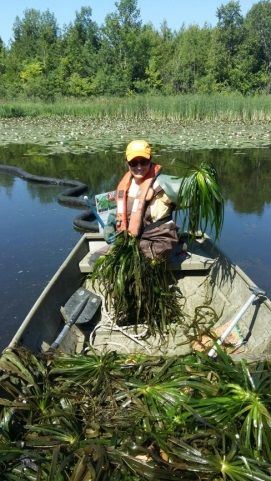
Figure: Water soldier being removed from the Black River by MNRF. Photo Credit: MNRF Aurora District.
Operation Bait Bucket Program
MNRF continued the Operation Bait Bucket Program this year by partnering with the Ontario Federation of Anglers and Hunters. Through this initiative, MNRF crews engaged ice anglers on Lake Simcoe about the importance of maintaining the health of the lake by stopping the spread of invasive species and diseases such as Viral Hemorrhagic Septicemia. Anglers were encouraged to buy locally produced bait and to never dump leftover baitfish or bait bucket contents onto the ice or into the lake.
Agriculture
The Lake Simcoe watershed contains some of the most productive agricultural land in Ontario, including the Holland Marsh. These lands generate over $300 million annually and are also close to large urban markets. Innovative agricultural practices and technologies, such as buffer strips along streams and rivers, cover crops and low-impact cropping and fertilizing methods, can help improve the health of the lake and its watershed.
Holland Marsh Sustainable Farming
In October 2016, the Ontario Ministry of Agriculture, Food and Rural Affairs (OMAFRA) and the Holland Marsh Growers’ Association launched a two-year initiative to assess the willingness of farmers to adopt the voluntary 4R approach (right nutrient source to apply at the right rate in the right place at the right time) as well as other on-farm projects to use water and energy more sustainably. The results of this pilot project will include recommendations on how best to remove the barriers to adopting the 4Rs by farmers in the watershed. Raising awareness of 4Rs will initially be approached through development of various education and outreach materials for Lake Simcoe farmers.
Preventing Phosphorus Loss from Farms during Storms
Also in October 2016, OMAFRA and the Canadian Water Network launched a two-year initiative to review research about phosphorus losses from agriculture during storm events and their potential effects on surface water quality. The project will also conduct a state-of-knowledge assessment on the effectiveness of current agricultural Best Management Practices (BMPs) to reduce phosphorus losses during storm events. Information from this project will help identify modifications to existing BMPs or new ones needed to effectively mitigate phosphorus losses anticipated from storm events. The results are expected to guide in part the design of future agricultural BMP programs delivered in the Lake Simcoe watershed where sensitivity to climate change impacts is a priority.
Soil Health Improvement
In December 2016, OMAFRA and the Ontario Soil and Crop Improvement Association launched a two-year initiative: the Lake Simcoe Soil Health Improvement Project. Through access to soil health check-ups consulting services provided by Certified Crop Advisors, farmers in the Lake Simcoe watershed will identify areas on their farms where they can make changes to their practices to improve soil health and water quality. Farmers will then have access to cost-share funding for up to eight BMPs.
The project includes a retrospective (2005 to present) data analysis of BMP projects delivered in the Lake Simcoe watershed by the Ontario Soil and Crop Improvement Association. This analysis will help improve the effectiveness of future farm stewardship programs through potential improvements in design and delivery of cost-share programs in the watershed. This project will contribute to the reduction of agricultural non-point source losses of phosphorus and other nutrients through the implementation of BMPs that improve soil health and water quality that are specifically tailored to the farmland characteristics and needs of farmers in the Lake Simcoe watershed.
Recreation
The Lake Simcoe watershed provides diverse recreational opportunities, from ice-fishing and snowmobiling in the winter to boating, fishing and hiking in the summer. These nature-based recreational opportunities attract thousands of residents and visitors. Research and monitoring are helping to manage recreational activities that have the potential to impact water quality, water quantity, aquatic life and the spread of invasive species so that everyone can enjoy Lake Simcoe now and in the future.
Researching Causes of Beach Closures
Beaches on Lake Simcoe are popular places for a variety of recreational users because of the clean water. Health units routinely sample water at beaches and post warnings when sampling exceeds 100 Escherichia coli (E. coli)/100 millilitres of water. Researchers at Western University are completing beach surveys to investigate how groundwater discharge into Lake Simcoe may be contributing to elevated E. coli concentrations at these beaches. Understanding the interactions between sand and water supports efforts to reduce the frequency and duration of beach postings across Lake Simcoe allowing people to enjoy the beaches more often.
The No Straw Challenge
Plastic straws, often served with drinks in restaurants, are only used for a short time yet persist in the environment for much longer. In an effort to raise awareness Tourism Barrie undertook a public awareness campaign called The No Straw Challenge with the tourism sector. Restaurants were encouraged to stop providing customers with plastic straws while educating them about plastic straws ending up in tributaries and the lake. The challenge supported Tourism Barrie’s programming to encourage tourism operators to adopt sustainability practices listed in their greening guides.
Appendix
Advice from the Minister’s Advisory Committees
Two publicly appointed committees were established in 2010 under the Lake Simcoe Protection Act – the Lake Simcoe Coordinating Committee and the Lake Simcoe Science Committee. These committees provide advice to the Minister of the Environment and Climate Change on the implementation of the Lake Simcoe Protection Plan and the ecological health of the Lake Simcoe watershed.
In addition to regular advice provided to provincial staff during committee meetings, the committees submitted five joint priority recommendations to the minister for 2016. Advice provided by the committee informs the adaptive management process and focused on five key areas:
- an effective strategy for watershed-wide communications and engagement is essential to amplify results and to secure support for the Lake Simcoe Protection Plan
- create regulation or policy to enable the Lake Simcoe Phosphorus Offsetting Program by establishing a:
- “zero phosphorus export” requirement for all new development
- compensatory framework when the zero export criteria cannot be achieved to generate revenue to remediate uncontrolled urban areas and reduce the urban phosphorus load
- develop regulations for road salt use that would require training and certification for salt applicators, as well as the identification and protection of salt-vulnerable areas within the watershed
- two-way knowledge transfer and meaningful consultation with Indigenous peoples, on climate change and water quality issues, are needed
- supporting and resourcing innovative projects continues to be essential – in particular, the scaling-up of successful pilot projects designed to improve watershed health and enhance sustainable development within the watershed. Innovation in scientific, social and economic approaches is the only way that population growth can be sustainable in the watershed
Following the March 2017 meeting between the minister and the Chairs, provincial staff are working with watershed partners to implement their recommendations. For example, a communications working group has been formed to begin developing a strategy for enhanced watershed-wide communications and engagement.
The province has continued its commitment to take strong action to protect and restore the ecological health of Lake Simcoe and its watershed and would like to thank all committee members for their commitment to Lake Simcoe and for providing their best advice.